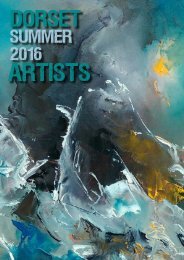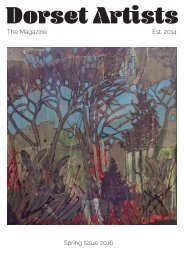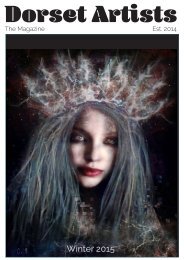Summer 2016 b
You also want an ePaper? Increase the reach of your titles
YUMPU automatically turns print PDFs into web optimized ePapers that Google loves.
When you look back on your<br />
life there are always regrets.<br />
One of mine is that I left it until<br />
I was in my forties to try<br />
and earn a living as an artist.<br />
I’ve always loved art, it was my joint<br />
favourite subject at school along with<br />
woodwork but when I left school life took<br />
me in a different direction. About seven<br />
years ago circumstances meant that I had<br />
to find another job. I’ve always worked<br />
with my hands so naturally I wanted to<br />
do something creative, I started collecting<br />
driftwood and making mirror frames.<br />
This led to making other items from driftwood.<br />
I started painting on driftwood,<br />
then wood panels, then canvas.<br />
I currently favour working on panels as I<br />
like a solid surface to withstand vigorous<br />
brush and knife work.<br />
I’m classed as self taught but who can really<br />
claim to have taught themself? With the<br />
abundance of source material around nowadays<br />
you can study any artist’s methods<br />
and processes learning as you research and<br />
experiment along the way. I much prefer<br />
trying to work things out myself by studying<br />
other artist’s work than being shown<br />
how to do things from a series of instructions.<br />
I feel that finding your own way helps<br />
you to develop a greater understanding of<br />
methods and principles. It doesn’t work for<br />
everyone but it suits me fine. In a way I’m<br />
being taught by the best teachers there have<br />
ever been.<br />
A common question is “which artist is<br />
your favourite?” This is a difficult one as<br />
I like and appreciate many artists, but if<br />
I had to name three, at the moment they<br />
would be Van Gogh, Picasso & Turner.<br />
Turner’s skies are just something else.<br />
The atmosphere he captured in his work<br />
virtually jumps off the wall at you and<br />
grabs your attention. Van Gogh’s energy<br />
and determination to succeed were<br />
remarkable and this comes through in<br />
his wonderful work. It’s such a shame<br />
he was never appreciated to the full extent<br />
when he was alive. His paintings<br />
certainly thrive today with the life that<br />
was so prematurely snuffed out in such<br />
a sad way. Picasso was a natural artist<br />
who developed art in an unusual and<br />
unique way pushing the boundaries of<br />
his art at the time. I suppose these are the<br />
marks I aim for and it’s this inspiration<br />
that drives me on .<br />
My main goal with a piece of work is to<br />
provoke an emotional reaction from the<br />
viewer. I think skies can do this well because<br />
a sky can so easily reflect human<br />
feelings like peace, excitement, foreboding<br />
and darkness and people can relate<br />
to these. With a foreboding sky I will<br />
often provide the viewer with a glimpse<br />
of blue or bright sky giving a feeling of<br />
hope beyond the despair.<br />
Over the last six months or so I’ve worked<br />
from a limited palette. I find that this really<br />
unifies my work and makes<br />
me think more about how to achieve a certain<br />
hue without reaching for a tube of ready made<br />
pigment. It’s really interesting what colours<br />
you produce along the way when you mix<br />
your own. The only trouble is remembering<br />
to note down how you did it, otherwise forget<br />
trying to repeat it exactly!<br />
When it comes to subject matter, landscapes<br />
are my chosen area of concentration along<br />
with seascapes and occasionally some urbanscapes.<br />
Getting outside into the elements is<br />
important to me and I like to record the feel<br />
of a place with sketches and reference photos<br />
to work from when I’m back in the studio. I<br />
recently saw an artists sketches which were<br />
shown alongside his finished paintings and on<br />
these sketches he noted down all of his sensory<br />
observations such as sounds, smells, feel<br />
of the air, brightness etc, in fact anything that<br />
would aid him in his accurate portrayal of<br />
the scene. It brought home to me that all<br />
these things are necessary because they<br />
are the vital ingredients that make up the<br />
finished work and breathe life into a painting,<br />
there’s more to it than just projecting<br />
an image, it’s about projecting a whole experience.<br />
With recent work finished for a summer<br />
exhibition I’m now thinking ahead to my<br />
next series of paintings. I have some ideas<br />
which I’m working on. That’s what I love<br />
about producing art, you’re always aiming<br />
for your next goal and looking for some<br />
new angle or perspective. There’s always<br />
something new to strive for on the horizon,<br />
and that’s the good thing about the<br />
horizon, you can never reach it but it’s always<br />
in sight.<br />
29 30









